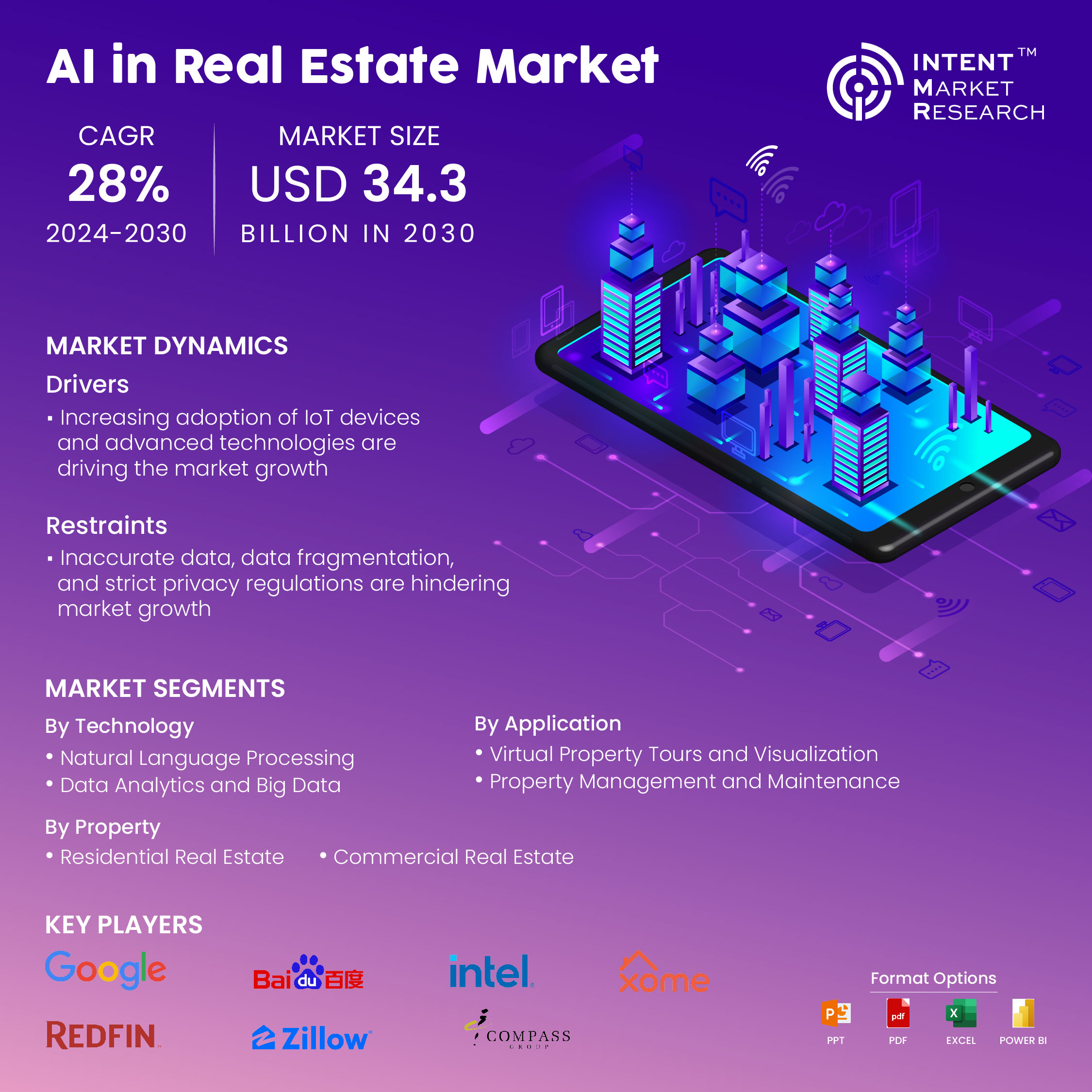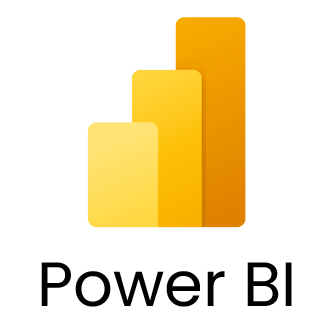AI in Real Estate Market
- December, 2023
- Technology, Media, and Telecom
AI in Real Estate Market Size Analysis by Technology (Natural Language Processing (NLP), Machine Learning and Predictive Analytics, Data Analytics and Big Data, Computer Vision and Image Recognition), by Application Type (Virtual Property Tours and Visualization, Property Management and Maintenance, Facility Management and Smart Buildings, Property Valuation, and Appraisal), by Property Type (Residential Real Estate & Commercial Real Estate) and by Region; Growth Trends and Forecasts (2024 - 2030)
As per Intent Market Research, the AI in real estate market size is expected to grow from USD 2.2 billion in 2023 to USD XX billion by 2030, at a CAGR of xx% during the forecast period (2024-2030). The AI in real estate market is segmented by technology, property type, application, and region.
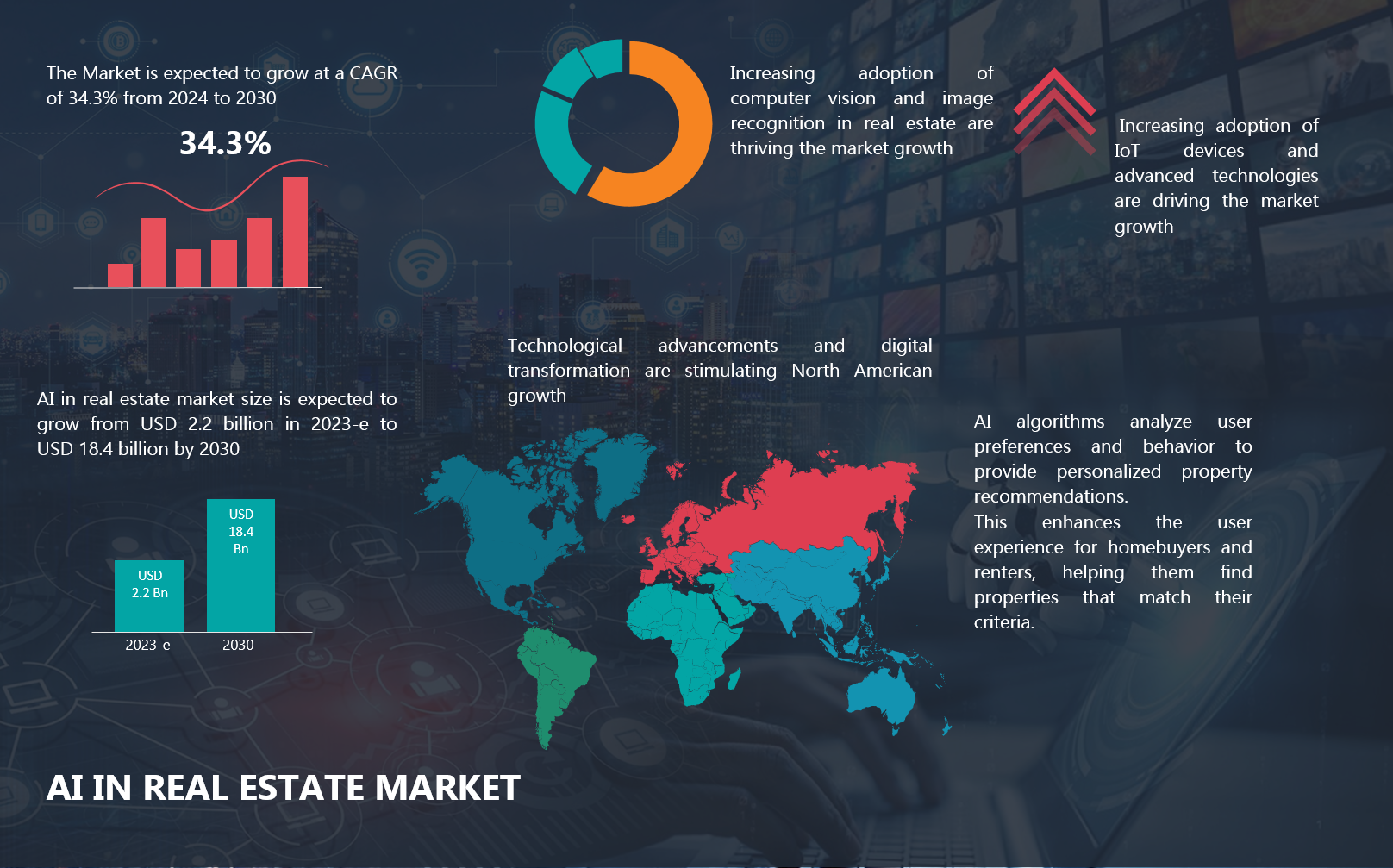
Artificial Intelligence (AI) in real estate refers to the use of advanced computer algorithms and machine learning techniques to analyze and process large volumes of data in the real estate industry. AI technologies are employed to streamline and enhance various aspects of real estate operations, from property searches and valuation to property management and customer service. AI in the real estate sector strives to enhance efficiency, accuracy, and data-driven processes, ultimately providing benefits to real estate professionals, buyers, sellers, and investors.
AI in real estate encompasses applications such as automated property valuation, predictive analytics, chatbots for customer inquiries, personalized property recommendations, and the automation of routine tasks such as paperwork processing and maintenance scheduling. These AI-driven solutions help real estate professionals to make informed decisions, improve the customer experience, and optimize their business operations.
Increasing adoption of IoT devices and advanced technologies are driving the market growth
AI in real estate market growth is driven by the increasing adoption of IoT devices, advanced technologies such as big data and machine learning, smart devices, and internet services. The AI-powered Automated Valuation Models (AVMs) offer more accurate property valuations, helping buyers, sellers, and lenders make informed decisions. As per the Zillow reports AI-powered AVMs have reduced the median error rate in home value estimates to around 1.9% in the United States.
AI-driven chatbots and virtual assistants enhance customer service by delivering prompt responses and personalized property recommendations. This, in turn, boosts customer satisfaction and engagement. For instance, The National Association of Realtors found that 44% of homebuyers preferred using chatbots for quick responses to inquiries. AI technologies automate routine tasks, reducing manual workloads for real estate professionals, and contributing to cost savings. Besides this, AI algorithms analyze user preferences and behavior to provide tailored suggestions, enhancing user engagement.
AI is employed to optimize energy usage in buildings, making properties more sustainable and energy-efficient. Integrating blockchain technology with AI enhances transparency and security in real estate transactions, minimizing fraud and errors. The real estate technology sector (PropTech) has seen significant investment and innovation, with AI playing a central role in this growth.
Inaccurate data, data fragmentation, and strict privacy regulations are hindering market growth
Artificial Intelligence (AI) is growing in the real estate industry, however faces several challenges related to inaccurate data, data fragmentation, and strict privacy regulations. Traditional practices and workflows pose obstacles to adoption, while the substantial upfront investments needed for AI systems could be challenging for smaller firms to allocate resources.
Integrating AI with existing tools and databases could be complex, and compliance with regulations could be challenging. Furthermore, ethical considerations, such as algorithmic bias, are also a concern. Besides this, the fragmented real estate market requires different AI solutions for different regions and property types. Despite these challenges, AI adoption in the real estate industry is steadily increasing with technological advancements, regulatory compliance, educational initiatives, and a willingness to embrace change within the industry.
Increasing adoption of computer vision and image recognition in real estate are thriving the market growth
Computer vision and image recognition technologies are essential in the real estate industry, elevating property valuation, search processes, marketing strategies, and overall customer experiences. These technologies improve automated property valuation models, allowing for immersive virtual tours and personalized recommendations. For instance, Restb.ai introduced a New Valuation Product Suite in August 2023, aiming to modernize property appraisals and streamline inspections with the introduction of new GSE standards. The visual-centric nature of the real estate industry and advancements in cloud computing and storage have made it easier to apply these technologies, making them a significant presence in the AI landscape of the real estate market.
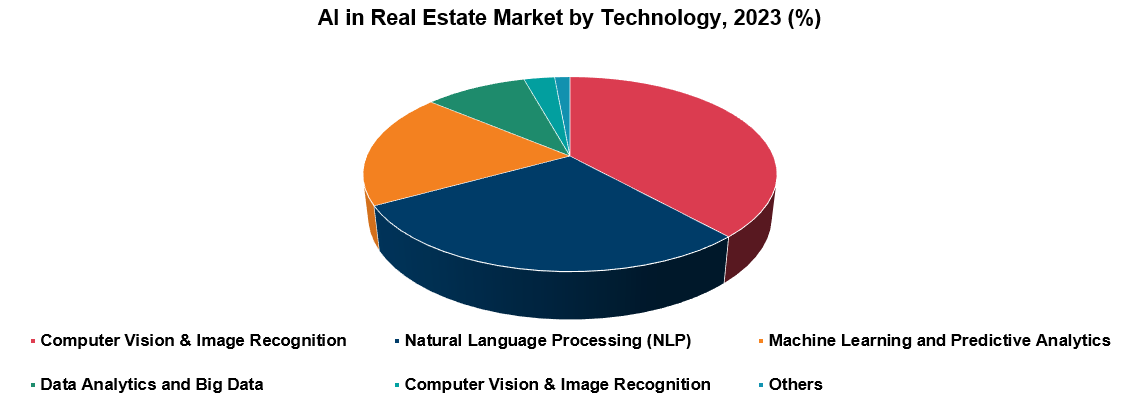
Facility management and smart buildings are enhancing the operational efficiency & user experience of property
Facility management and smart buildings application segment is gaining popularity due to their energy efficiency, cost reduction, and maintenance efficiency. AI-based systems optimize energy consumption, predict maintenance, and improve building performance. Smart buildings offer comfort, security, and revenue generation, making them attractive to tenants and buyers in competitive markets. Spacewell and TCM IP Services collaborated to elevate user experiences and optimize energy consumption, offering seamless, intuitive solutions for building owners and occupants. Artificial intelligence (AI) adoption in facility management and smart buildings propels real estate market growth by enhancing operational efficiency and user experiences for property owners, managers, and tenants.
AI is revolutionizing the commercial real estate sector
AI is revolutionizing commercial real estate by providing increased operational efficiency, reduced costs, and improved decision-making. It can analyze vast amounts of data, including market trends, property values, and financial metrics, to provide valuable insights. AI can enhance property valuation accuracy, predict future trends, and help property managers manage tenant relationships and leases. It can optimize space utilization, improve maintenance, and enhance tenant experiences. AI plays a role in assessing and mitigating investment risks, optimizing energy consumption, and enhancing the competitiveness of properties. It can also assist in compliance and due diligence processes by automating document review, contract analysis, and regulatory compliance checks. Henceforth, AI adoption in commercial real estate boosts efficiency, reduces costs, improves decision-making, and offers modern, tech-enabled spaces, with its role expected to grow further as AI advances.
Technological advancements and digital transformation are stimulating North American growth
North America AI market in real estate is experiencing significant growth due to technological advancements and digital transformation in the construction industry. North America, particularly the US, has seen significant investment in real estate technology, particularly AI-driven solutions, reaching USD 23.8 billion in 2021. Incorporating residential, commercial, and industrial properties, North America presents opportunities for AI-driven applications within a diverse market.
Major technology hubs such as Silicon Valley, Boston, and New York are at the forefront of AI innovation in the real estate industry. High expectations for technology-driven amenities and services in real estate include smart buildings, efficient property management, and personalized experiences. The region’s economic activity and dynamic real estate market provide fertile ground for AI technologies, offering efficiency, cost savings, and better decision-making. The North American real estate sector is integrating AI technologies to enhance productivity, safety, and project outcomes, with a growing ecosystem of providers, firms, and research institutions which is driving the regional growth.
Product innovations is the key strategy adopted by major market players
The AI in Real Estate market is highly competitive, with numerous international and domestic players vying for market share. Key players in this market include Intel Corporation, Compass Group, Google, Xome, Redfin, Zillow, Baidu Inc., Homebot, Stavvy, Evolve, Keyway, Buildout, Inc., Endpoint, and View Profile. & Findigs, Inc. These industry leaders are focused on continuous innovation to meet the evolving preferences and needs of consumers. The ability to adapt to changing market trends and consumer preferences is crucial for success in the market.
- On Aug. 30, 2023, Backflip announced the launch of My Leads, an AI-enabled property-sourcing feature
- On September 8, 2023, Revive released a new tool named “Revive Vision AI” designed to assist real estate professionals in property valuation.
- On November 01, 2023, reAlpha Announces Commercial Launch of GENA, a Product for Property Listing Descriptions Powered by Generative-AI
- On 13 March 2023, Magicbricks launched, an AI-based market scanner to help builders, and brokers in sales, AI-powered virtual tour platforms, and augmented reality apps are becoming more sophisticated, allowing prospective buyers and renters to explore properties remotely with a high level of detail
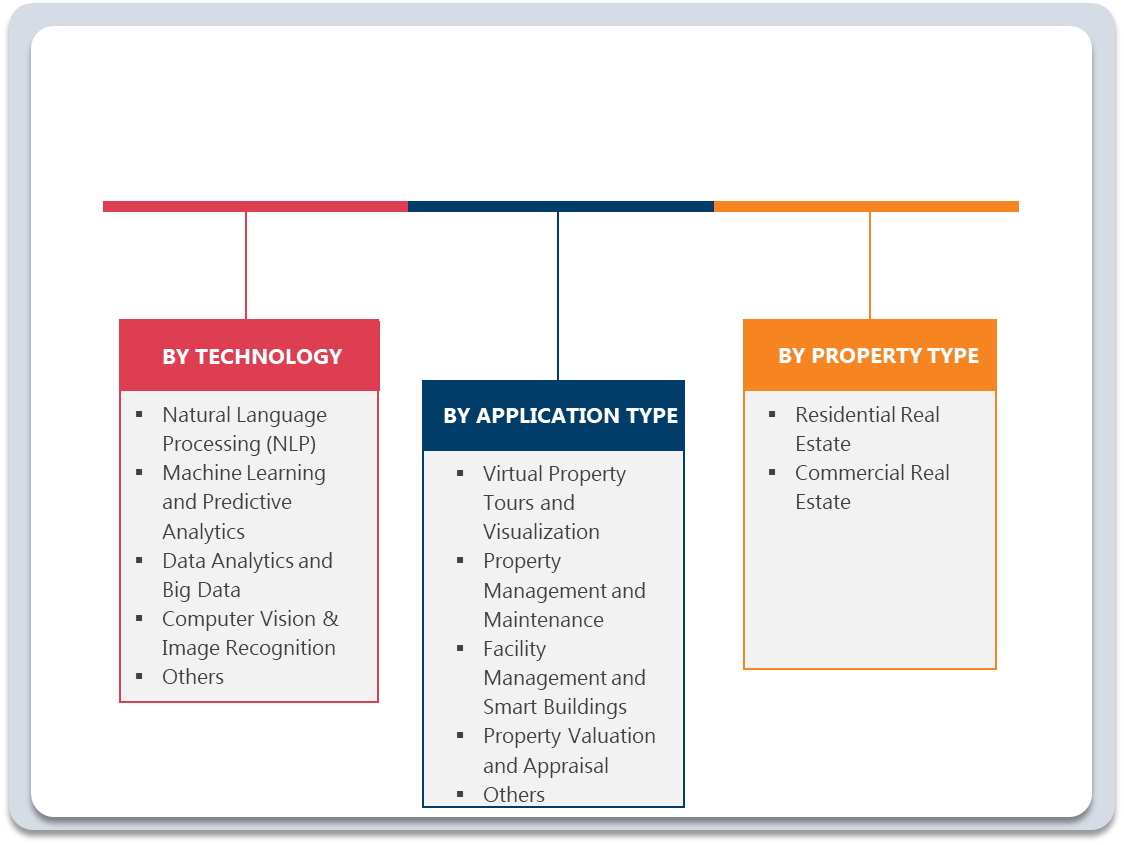
Report Scope
Report Features | Description |
Market Value (2023-e) | USD 2.2 billion |
Forecast Revenue (2030) | USD 18.4 billion |
CAGR (2024-2030) | 34.3% |
Base Year for Estimation | 2023-e |
Historical Period | 2022 |
Forecast Period | 2024-2030 |
Report Coverage | Revenue Forecast, Market Dynamics, Competitive Landscape, Recent Developments |
Segments Covered | By Technology (Natural Language Processing (NLP), Machine Learning & Predictive Analytics, Data Analytics & Big Data, Computer Vision & Image Recognition, Others), By Application Type (Virtual Property Tours & Visualization, Property Management & Maintenance, Facility Management & Smart Buildings, Property Valuation & Appraisal, Others), By Property Type (Residential Real Estate, Commercial Real Estate) |
Regional Analysis | North America (US, Canada), Europe (Germany, France, UK, Spain, Italy), Asia-Pacific (China, Japan, South Korea, India), Latin America (Brazil, Mexico, Argentina), Middle East & Africa (Saudi Arabia, South Africa, Turkey, United Arab Emirates) |
Competitive Landscape | Aalto, Baidu, Buildout, Compass, Endpoint, Evolve, Findigs, Google, Homebot, Intel, Keyway, Mint House, Mosaic Building, Nomad, OJO, Opendoor, Redfin, Redfin, Rex, Rhino, Stavvy, TestFit, The Rockport Group, The Guarantors, Truehold, Up&Up, Xome & Zillow. |
Customization Scope | Customization for segments, region/country-level will be provided. Moreover, additional customization can be done based on the requirements. |
Purchase Options | We have three licenses to opt for Single User License, Multi-User License (Up to 5 Users), Corporate Use License (Unlimited User and Printable PDF) |
1. Introduction |
1. 1. Study Assumptions and AI in Real Estate Market Definition |
1.2. Scope of the Study |
2. Research Methodology |
3. Executive Summary |
4. AI in Real Estate Market Dynamics |
4.1. Market Growth Drivers |
4.2 Market Growth Challenges |
5. AI in Real Estate Market Outlook |
5.1. Use Case studies |
5.2 AI is revolutionizing the residential real estate industry |
5.3. The Impact of AI on Commercial Real Estate |
5.4 AI is shaping the future of real estate: Opportunity Analysis |
5.5. The ethics of artificial intelligence: Issues and initiatives 5.6. Porter’s Five forces 5.7 Pestle Analysis 5.8 BCG Matrix Analysis 5.9 Investment Analysis |
6. Global AI in Real Estate Market Segmentation (Market Size and Forecast by Value – USD billion, 2022 – 2028) |
6.1 Technology |
6.1.1 Natural Language Processing (NLP) |
6.1.2 Machine Learning and Predictive Analytics |
6.1.3 Data Analytics and Big Data |
6.1.4 Computer Vision & Image Recognition |
6.1.5 Others |
6.2 Application Type |
6.2.1 Virtual Property Tours and Visualization |
6.2.2 Property Management and Maintenance |
6.2.3 Facility Management and Smart Building |
6.2.4 Property Valuation and Appraisal |
6.2.5 Others |
6.3 Property Type |
6.3.1 Residential Real Estate |
6.3.2 Commercial Real Estate |
6.4 Geography |
6.4.1 North America |
6.4.2 Europe |
6.4.3 Asia-Pacific |
6.4.4 Latin America |
6.4.5 Middle East and Africa |
7. North America AI in Real Estate Market Segmentation (Market Size and Forecast by Value – USD billion, 2022 – 2028) |
7.1 Technology |
7.1.1 Natural Language Processing (NLP) |
7.1.2 Machine Learning and Predictive Analytics |
7.1.3 Data Analytics and Big Data |
7.1.4 Computer Vision & Image Recognition |
7.1.5 Others |
7.2 Application Type |
7.2.1 Virtual Property Tours and Visualization |
7.2.2 Property Management and Maintenance |
7.2.3 Facility Management and Smart Building |
7.2.4 Property Valuation and Appraisal |
7.2.5 Others |
7.3 Property Type |
7.3.1 Residential Real Estate |
7.3.2 Commercial Real Estate |
7.4 Country |
7.4.1 United States |
7.4.1.1 Technology |
7.4.1.1.1 Natural Language Processing (NLP) |
7.4.1.1.2 Machine Learning and Predictive Analytics |
7.4.1.1.3 Data Analytics and Big Data |
7.4.1.1.4 Computer Vision & Image Recognition |
7.4.1.1.5 Others |
7.4.1.2 Application Type |
7.4.1.2.1 Virtual Property Tours and Visualization |
7.4.1.2.2 Property Management and Maintenance |
7.4.1.2.3 Facility Management and Smart Building |
7.4.1.2.4 Computer Vision & Image Recognition |
7.4.1.2.5 Others |
7.4.1.3 Property Type |
7.4.1.3.1 Residential Real Estate |
7.4.1.3.2 Commercial Real Estate |
7.4.2 Canada |
7.4.2.1 Technology |
7.4.2.1.1 Natural Language Processing (NLP) |
7.4.2.1.2 Machine Learning and Predictive Analytics |
7.4.2.1.3 Data Analytics and Big Data |
7.4.2.1.4 Computer Vision & Image Recognition |
7.4.2.1.5 Others |
7.4.2.2 Application Type |
7.4.2.2.1 Virtual Property Tours and Visualization |
7.4.2.2.2 Property Management and Maintenance |
7.4.2.2.3 Facility Management and Smart Building |
7.4.2.2.4 Computer Vision & Image Recognition |
7.4.2.2.5 Others |
7.4.2.3 Property Type |
7.4.2.3.1 Residential Real Estate |
7.4.2.3.2 Commercial Real Estate |
8. Europe Market AI in Real Estate Segmentation (Market Size and Forecast by Value – USD billion, 2022 – 2028) |
8.1 Technology |
8.1.1 Natural Language Processing (NLP) |
8.1.2 Machine Learning and Predictive Analytics |
8.1.3 Data Analytics and Big Data |
8.1.4 Computer Vision & Image Recognition |
8.1.5 Others |
8.2 Application Type |
8.2.1 Virtual Property Tours and Visualization |
8.2.2 Property Management and Maintenance |
8.2.3 Facility Management and Smart Building |
8.2.4 Property Valuation and Appraisal |
8.2.5 Others |
8.3 Property Type |
8.3.1 Residential Real Estate |
8.3.2 Commercial Real Estate |
8.4 Country |
8.4.1 United Kingdom |
8.4.1.1 Technology |
8.4.1.1.1 Natural Language Processing (NLP) |
8.4.1.1.2 Machine Learning and Predictive Analytics |
8.4.1.1.3 Data Analytics and Big Data |
8.4.1.1.4 Computer Vision & Image Recognition |
8.4.1.1.5 Others |
8.4.1.2 Application Type |
8.4.1.2.1 Virtual Property Tours and Visualization |
8.4.1.2.2 Property Management and Maintenance |
8.4.1.2.3 Facility Management and Smart Building |
8.4.1.2.4 Computer Vision & Image Recognition |
8.4.1.2.5 Others |
8.4.1.3 Property Type |
8.4.1.3.1 Residential Real Estate |
8.4.1.3.2 Commercial Real Estate |
8.4.2 France |
8.4.2.1 Technology |
8.4.2.1.1 Natural Language Processing (NLP) |
8.4.2.1.2 Machine Learning and Predictive Analytics |
8.4.2.1.3 Data Analytics and Big Data |
8.4.2.1.4 Computer Vision & Image Recognition |
8.4.2.1.5 Others |
8.4.2.2 Application Type |
8.4.2.2.1 Virtual Property Tours and Visualization |
8.4.2.2.2 Property Management and Maintenance |
8.4.2.2.3 Facility Management and Smart Building |
8.4.2.2.4 Computer Vision & Image Recognition |
8.4.2.2.5 Others |
8.4.2.3 Property Type |
8.4.2.3.1 Residential Real Estate |
8.4.2.3.2 Commercial Real Estate |
8.4.3 Germany |
8.4.3.1 Technology |
8.4.3.1.1 Natural Language Processing (NLP) |
8.4.3.1.2 Machine Learning and Predictive Analytics |
8.4.3.1.3 Data Analytics and Big Data |
8.4.3.1.4 Computer Vision & Image Recognition |
8.4.3.1.5 Others |
8.4.3.2 Application Type |
8.4.3.2.1 Virtual Property Tours and Visualization |
8.4.3.2.2 Property Management and Maintenance |
8.4.3.2.3 Facility Management and Smart Building |
8.4.3.2.4 Computer Vision & Image Recognition |
8.4.3.2.5 Others |
8.4.3.3 Property Type |
8.4.3.3.1 Residential Real Estate |
8.4.3.3.2 Commercial Real Estate |
8.4.4 Italy |
8.4.4.1 Technology |
8.4.4.1.1 Natural Language Processing (NLP) |
8.4.4.1.2 Machine Learning and Predictive Analytics |
8.4.4.1.3 Data Analytics and Big Data |
8.4.4.1.4 Computer Vision & Image Recognition |
8.4.4.1.5 Others |
8.4.4.2 Application Type |
8.4.4.2.1 Virtual Property Tours and Visualization |
8.4.4.2.2 Property Management and Maintenance |
8.4.4.2.3 Facility Management and Smart Building |
8.4.4.2.4 Computer Vision & Image Recognition |
8.4.4.2.5 Others |
8.4.4.3 Property Type |
8.4.4.3.1 Residential Real Estate |
8.4.4.3.2 Commercial Real Estate |
8.4.5 Rest of Europe |
8.4.5.1 Technology |
8.4.5.1.1 Natural Language Processing (NLP) |
8.4.5.1.2 Machine Learning and Predictive Analytics |
8.4.5.1.3 Data Analytics and Big Data |
8.4.5.1.4 Computer Vision & Image Recognition |
8.4.5.1.5 Others |
8.4.5.2 Application Type |
8.4.5.2.1 Virtual Property Tours and Visualization |
8.4.5.2.2 Property Management and Maintenance |
8.4.5.2.3 Facility Management and Smart Building |
8.4.5.2.4 Computer Vision & Image Recognition |
8.4.5.2.5 Others |
8.4.5.3 Property Type |
8.4.5.3.1 Residential Real Estate |
8.4.5.3.2 Commercial Real Estate |
9. Asia Pacific AI in Real Estate Market Segmentation (Market Size and Forecast by Value – USD billion, 2022 – 2028) |
9.1 Technology |
9.1.1 Natural Language Processing (NLP) |
9.1.2 Machine Learning and Predictive Analytics |
9.1.3 Data Analytics and Big Data |
9.1.4 Computer Vision & Image Recognition |
9.1.5 Others |
9.2 Application Type |
9.2.1 Virtual Property Tours and Visualization |
9.2.2 Property Management and Maintenance |
9.2.3 Facility Management and Smart Building |
9.2.4 Property Valuation and Appraisal |
9.2.5 Others |
9.3 Property Type |
9.3.1 Residential Real Estate |
9.3.2 Commercial Real Estate |
9.4 Country |
9.4.1 China |
9.4.1.1 Technology |
9.4.1.1.1 Natural Language Processing (NLP) |
9.4.1.1.2 Machine Learning and Predictive Analytics |
9.4.1.1.3 Data Analytics and Big Data |
9.4.1.1.4 Computer Vision & Image Recognition |
9.4.1.1.5 Others |
9.4.1.2 Application Type |
9.4.1.2.1 Virtual Property Tours and Visualization |
9.4.1.2.2 Property Management and Maintenance |
9.4.1.2.3 Facility Management and Smart Building |
9.4.1.2.4 Computer Vision & Image Recognition |
9.4.1.2.5 Others |
9.4.1.3 Property Type |
9.4.1.3.1 Residential Real Estate |
9.4.1.3.2 Commercial Real Estate |
9.4.2 Japan |
9.4.2.1 Technology |
9.4.2.1.1 Natural Language Processing (NLP) |
9.4.2.1.2 Machine Learning and Predictive Analytics |
9.4.2.1.3 Data Analytics and Big Data |
9.4.2.1.4 Computer Vision & Image Recognition |
9.4.2.1.5 Others |
9.4.2.2 Application Type |
9.4.2.2.1 Virtual Property Tours and Visualization |
9.4.2.2.2 Property Management and Maintenance |
9.4.2.2.3 Facility Management and Smart Building |
9.4.2.2.4 Computer Vision & Image Recognition |
9.4.2.2.5 Others |
9.4.2.3 Property Type |
9.4.2.3.1 Residential Real Estate |
9.4.2.3.2 Commercial Real Estate |
9.4.3 India |
9.4.3.1 Technology |
9.4.3.1.1 Natural Language Processing (NLP) |
9.4.3.1.2 Machine Learning and Predictive Analytics |
9.4.3.1.3 Data Analytics and Big Data |
9.4.3.1.4 Computer Vision & Image Recognition |
9.4.3.1.5 Others |
9.4.3.2 Application Type |
9.4.3.2.1 Virtual Property Tours and Visualization |
9.4.3.2.2 Property Management and Maintenance |
9.4.3.2.3 Facility Management and Smart Building |
9.4.3.2.4 Computer Vision & Image Recognition |
9.4.3.2.5 Others |
9.4.3.3 Property Type |
9.4.3.3.1 Residential Real Estate |
9.4.3.3.2 Commercial Real Estate |
9.4.4 South Korea |
9.4.4.1 Technology |
9.4.4.1.1 Natural Language Processing (NLP) |
9.4.4.1.2 Machine Learning and Predictive Analytics |
9.4.4.1.3 Data Analytics and Big Data |
9.4.4.1.4 Computer Vision & Image Recognition |
9.4.4.1.5 Others |
9.4.4.2 Application Type |
9.4.4.2.1 Virtual Property Tours and Visualization |
9.4.4.2.2 Property Management and Maintenance |
9.4.4.2.3 Facility Management and Smart Building |
9.4.4.2.4 Computer Vision & Image Recognition |
9.4.4.2.5 Others |
9.4.4.3 Property Type |
9.4.4.3.1 Residential Real Estate |
9.4.4.3.2 Commercial Real Estate |
9.4.5 Rest of Asia Pacific |
9.4.5.1 Technology |
9.4.5.1.1 Natural Language Processing (NLP) |
9.4.5.1.2 Machine Learning and Predictive Analytics |
9.4.5.1.3 Data Analytics and Big Data |
9.4.5.1.4 Computer Vision & Image Recognition |
9.4.5.1.5 Others |
9.4.5.2 Application Type |
9.4.5.2.1 Virtual Property Tours and Visualization |
9.4.5.2.2 Property Management and Maintenance |
9.4.5.2.3 Facility Management and Smart Building |
9.4.5.2.4 Computer Vision & Image Recognition |
9.4.5.2.5 Others |
9.4.5.3 Property Type |
9.4.5.3.1 Residential Real Estate |
9.4.5.3.2 Commercial Real Estate |
10. Latin America AI in Real Estate Market Segmentation (Market Size and Forecast by Value – USD billion, 2022 – 2028) |
10.1 Technology |
10.1.1 Natural Language Processing (NLP) |
10.1.2 Machine Learning and Predictive Analytics |
10.1.3 Data Analytics and Big Data |
10.1.4 Computer Vision & Image Recognition |
10.1.5 Others |
10.2 Application Type |
10.2.1 Virtual Property Tours and Visualization |
10.2.2 Property Management and Maintenance |
10.2.3 Facility Management and Smart Building |
10.2.4 Property Valuation and Appraisal |
10.2.5 Others |
10.3 Property Type |
10.3.1 Residential Real Estate |
10.3.2 Commercial Real Estate |
10.4 Country |
10.4.1 Brazil |
10.4.1.1 Technology |
10.4.1.1.1 Natural Language Processing (NLP) |
10.4.1.1.2 Machine Learning and Predictive Analytics |
10.4.1.1.3 Data Analytics and Big Data |
10.4.1.1.4 Computer Vision & Image Recognition |
10.4.1.1.5 Others |
10.4.1.2 Application Type |
10.4.1.2.1 Virtual Property Tours and Visualization |
10.4.1.2.2 Property Management and Maintenance |
10.4.1.2.3 Facility Management and Smart Building |
10.4.1.2.4 Computer Vision & Image Recognition |
10.4.1.2.5 Others |
10.4.1.3 Property Type |
10.4.1.3.1 Residential Real Estate |
10.4.1.3.2 Commercial Real Estate |
10.4.2 Mexico |
10.4.2.1 Technology |
10.4.2.1.1 Natural Language Processing (NLP) |
10.4.2.1.2 Machine Learning and Predictive Analytics |
10.4.2.1.3 Data Analytics and Big Data |
10.4.2.1.4 Computer Vision & Image Recognition |
10.4.2.1.5 Others |
10.4.2.2 Application Type |
10.4.2.2.1 Virtual Property Tours and Visualization |
10.4.2.2.2 Property Management and Maintenance |
10.4.2.2.3 Facility Management and Smart Building |
10.4.2.2.4 Computer Vision & Image Recognition |
10.4.2.2.5 Others |
10.4.2.3 Property Type |
10.4.2.3.1 Residential Real Estate |
10.4.2.3.2 Commercial Real Estate |
10.4.3 Argentina |
10.4.3.1 Technology |
10.4.3.1.1 Natural Language Processing (NLP) |
10.4.3.1.2 Machine Learning and Predictive Analytics |
10.4.3.1.3 Data Analytics and Big Data |
10.4.3.1.4 Computer Vision & Image Recognition |
10.4.3.1.5 Others |
10.4.3.2 Application Type |
10.4.3.2.1 Virtual Property Tours and Visualization |
10.4.3.2.2 Property Management and Maintenance |
10.4.3.2.3 Facility Management and Smart Building |
10.4.3.2.4 Computer Vision & Image Recognition |
10.4.3.2.5 Others |
10.4.3.3 Property Type |
10.4.3.3.1 Residential Real Estate |
10.4.3.3.2 Commercial Real Estate |
10.4.4 Rest of Latin America |
10.4.4.1 Technology |
10.4.4.1.1 Natural Language Processing (NLP) |
10.4.4.1.2 Machine Learning and Predictive Analytics |
10.4.4.1.3 Data Analytics and Big Data |
10.4.4.1.4 Computer Vision & Image Recognition |
10.4.4.1.5 Others |
10.4.4.2 Application Type |
10.4.4.2.1 Virtual Property Tours and Visualization |
10.4.4.2.2 Property Management and Maintenance |
10.4.4.2.3 Facility Management and Smart Building |
10.4.4.2.4 Computer Vision & Image Recognition |
10.4.4.2.5 Others |
10.4.4.3 Property Type |
10.4.4.3.1 Residential Real Estate |
10.4.4.3.2 Commercial Real Estate |
11. Middle East & Africa AI in Real Estate Market Segmentation (Market Size and Forecast by Value – USD billion, 2022 – 2028) |
11.1 Technology |
11.1.1 Natural Language Processing (NLP) |
11.1.2 Machine Learning and Predictive Analytics |
11.1.3 Data Analytics and Big Data |
11.1.4 Computer Vision & Image Recognition |
11.1.5 Others |
11.2 Application Type |
11.2.1 Virtual Property Tours and Visualization |
11.2.2 Property Management and Maintenance |
11.2.3 Facility Management and Smart Building |
11.2.4 Property Valuation and Appraisal |
11.2.5 Others |
11.3 Property Type |
11.3.1 Residential Real Estate |
11.3.2 Commercial Real Estate |
11.4 Country |
11.4.1 United Arab Emirates |
11.4.1.1 Technology |
11.4.1.1.1 Natural Language Processing (NLP) |
11.4.1.1.2 Machine Learning and Predictive Analytics |
11.4.1.1.3 Data Analytics and Big Data |
11.4.1.1.4 Computer Vision & Image Recognition |
11.4.1.1.5 Others |
11.4.1.2 Application Type |
11.4.1.2.1 Virtual Property Tours and Visualization |
11.4.1.2.2 Property Management and Maintenance |
11.4.1.2.3 Facility Management and Smart Building |
11.4.1.2.4 Computer Vision & Image Recognition |
11.4.1.2.5 Others |
11.4.1.3 Property Type |
11.4.1.3.1 Residential Real Estate |
11.4.1.3.2 Commercial Real Estate |
11.4.2 Saudi Arabia |
11.4.2.1 Technology |
11.4.2.1.1 Natural Language Processing (NLP) |
11.4.2.1.2 Machine Learning and Predictive Analytics |
11.4.2.1.3 Data Analytics and Big Data |
11.4.2.1.4 Computer Vision & Image Recognition |
11.4.2.1.5 Others |
11.4.2.2 Application Type |
11.4.2.2.1 Virtual Property Tours and Visualization |
11.4.2.2.2 Property Management and Maintenance |
11.4.2.2.3 Facility Management and Smart Building |
11.4.2.2.4 Computer Vision & Image Recognition |
11.4.2.2.5 Others |
11.4.2.3 Property Type |
11.4.2.3.1 Residential Real Estate |
11.4.2.3.2 Commercial Real Estate |
11.4.3 South Africa |
11.4.3.1 Technology |
11.4.3.1.1 Natural Language Processing (NLP) |
11.4.3.1.2 Machine Learning and Predictive Analytics |
11.4.3.1.3 Data Analytics and Big Data |
11.4.3.1.4 Computer Vision & Image Recognition |
11.4.3.1.5 Others |
11.4.3.2 Application Type |
11.4.3.2.1 Virtual Property Tours and Visualization |
11.4.3.2.2 Property Management and Maintenance |
11.4.3.2.3 Facility Management and Smart Building |
11.4.3.2.4 Computer Vision & Image Recognition |
11.4.3.2.5 Others |
11.4.3.3 Property Type |
11.4.3.3.1 Residential Real Estate |
11.4.3.3.2 Commercial Real Estate |
11.4.4 Rest of Middle East and Africa |
11.4.4.1 Technology |
11.4.4.1.1 Natural Language Processing (NLP) |
11.4.4.1.2 Machine Learning and Predictive Analytics |
11.4.4.1.3 Data Analytics and Big Data |
11.4.4.1.4 Computer Vision & Image Recognition |
11.4.4.1.5 Others |
11.4.4.2 Application Type |
11.4.4.2.1 Virtual Property Tours and Visualization |
11.4.4.2.2 Property Management and Maintenance |
11.4.4.2.3 Facility Management and Smart Building |
11.4.4.2.4 Computer Vision & Image Recognition |
11.4.4.2.5 Others |
11.4.4.3 Property Type |
11.4.4.3.1 Residential Real Estate |
11.4.4.3.2 Commercial Real Estate |
12. Competitive Landscape |
12.1 Company Market Share Analysis |
12.2 Competitive Matrix |
12.2 Product Benchmarking |
12.3 Company Profiles (Manufacturers of AI in Real Estate) |
12.3.1 Intel Corporation |
12.3.1.1 Company Synopsis |
12.3.1.2 Company Financials |
12.3.1.3 Product/ Service Portfolio |
12.3.1.4 Recent Developments |
12.3.2 Compass Group |
12.3.3 Google |
12.3.4 Xome |
12.3.5 Redfin |
12.3.6 Zillow |
12.3.7 Baidu Inc. |
12.3.8 Homebot |
12.3.9 Stavvy |
12.3.10 Evolve |
12.3.11 Keyway |
12.3.12 Buildout, Inc. |
12.3.13 Endpoint |
12.3.14 View Profile. |
12.3.15 Findigs, Inc. |
12.4 Company Profiles (Demand Side) |
12.4.1 CBRE Group, Inc. |
12.4.1.1 Company Synopsis |
12.3.1.2 Company Financials |
12.3.1.3 Product/ Service Portfolio |
12.3.1.4 Recent Developments |
12.4.2 JLL (Jones Lang LaSalle) |
12.4.3 Colliers International |
12.4.4 Cushman & Wakefield |
12.4.5 Brookfield Asset Management |
*List Not Exhaustive |
Disclaimer: The list of all other companies will be mentioned under client requirements |
13. Analyst Recommendations |
We specialize in providing syndicated market research reports that are highly sought after. We can also provide tailored customization to meet unique requirements. Our commitment exceeds limits as we empower clients with tactical and strategic support for well-informed business decisions and consistent success. Our experienced team continuously pushes the boundaries in market research, focusing on emerging markets with unwavering dedication. We provide comprehensive insights into global, regional, and country-level data, leaving no aspect hidden in any target market. Our market forecasts will benefit you in the following ways::
- Grasp the market opportunity for new products and services.
- Distinguish between emerging, maturing, and declining market opportunities.
- Build your business plans and strategies on factual data, not conjecture.
We place a strong emphasis on ensuring that each step of the research process is executed with meticulous attention to detail, aiming for minimal errors, and maintaining complete transparency throughout. We leverage multiple research methodologies to conduct our studies:
Data Collection and Interpretation
As research analysts, we prioritize accuracy and in-depth analysis, employing a diverse array of sources. These sources can be categorized into three main channels:
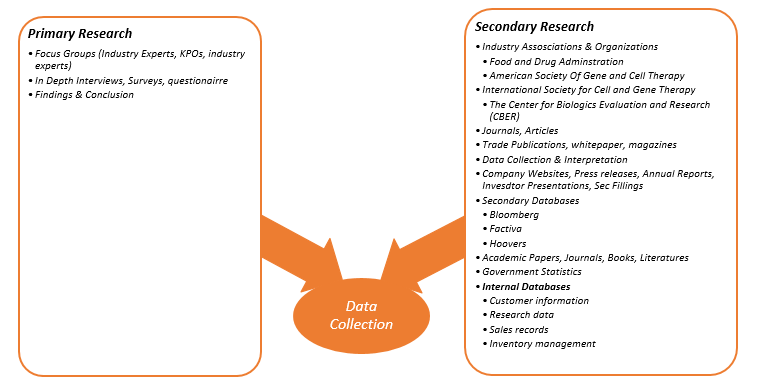
After collecting data from secondary and primary sources, we carefully examine the following to establish base numbers:
- Analyzing company revenues and their corresponding market share (involving the analysis of revenue data released by publicly listed manufacturers)
- Deriving market estimates by inspecting the primary market as well as its complementary markets
- Presenting key findings based on major segments and outlining top strategies by major players
- Analyzing the dynamics of the market, including drivers, opportunities, restraints, and challenges
- Assessing macro-economic factors and the regulatory framework influencing the market
- Evaluating market investment feasibility, conducting PEST and PORTER’s Five Force analyses
- Performing impact analysis of drivers and restraints, and conducting industry chain and cost structure analyses
- Creating opportunity maps, analyzing market competition scenarios, and conducting product life cycle analysis
- Identifying opportunity orbits and manufacturer intensity maps
- Analyzing major companies’ sales by value to gain comprehensive insights into the market
Market Sizing & Forecasting
We use both bottom-up and top-down approaches to segment and estimate quantitative aspects of the market. Our research reports also present data triangulation, which examines the market from three different perspectives.
- In the Bottom-Up Approach, we begin by collecting data at the micro-level, which includes individual data points and small samples. We aggregate and analyze the data to form broader conclusions and insights. We also include the market share of the vendors, which provides a granular view of the key players in the market, starting from the ground up. This approach is useful for industries with diverse segments and varied customer preferences. It is effective in exploratory research when we have little pre-existing knowledge and allows unexpected patterns and trends to emerge from data, leading to the creation of new theories.
- In the Top-Down Approach, we start with a macro-level view of the market, including the overall market size and industry trends. We analyze large-scale data and market indicators to make general assumptions. This approach provides a broader perspective and identifies the main market drivers and trends. We then narrow down the focus as data is scrutinized and specific segments are explored. This approach is effective for quickly assessing overall market potential and opportunities in various regions.

Consumer Behavior:
- Usage Rates and Patterns: Collect and analyze data on current product usage. It assists in product development and marketing strategies. Moreover, it also helps determine substitute rates.
- Market Penetration by User Base: Estimate the total market size and assess success in engaging potential consumers. Identify unmet needs and growth opportunities to enhance market penetration.
- Analyze market share, customer satisfaction, and preferences, providing insights into competitive positioning.
Historical/Empirical Data:
- Set initial figures to examine upcoming trends and to make well-informed decisions.
- Utilize exponential smoothing to forecast how a product might perform in the future, considering its trends and patterns over time.
Trend Analysis:
Conduct trend analysis using year-trending models to study historical data and identify patterns and trends that can influence future product penetration. This analysis aids in making proactive decisions and adapting strategies to capitalize on emerging opportunities and overcome challenges in the market.
Data Validation:
- Engage with in-house market analysts and industry experts to validate all collected data and cross-check it through calls or face-to-face interviews.
- Conduct thorough quality checks to validate the data included in the report and contact various members of our network to verify the data’s authenticity, resulting in error elimination and eradication of doubtful information.
- Correlate with standard KIPs to gain insights into future trends.
- Conduct multi-tier data validation through external thought leaders, market analysts, subject matter experts, comparative analysis, and review data collection instruments.
Continuous Monitoring: Final Report and Presentation
- Our team collaborates with industry experts to finalize and validate data. We utilize advanced data analysis models to generate valuable insights. Our integrated report comes with robust analytics and advanced visualization capabilities to ensure consistency and efficiency. We implement a standardized content management approach, common tagging, and taxonomy structure for seamless information connectivity. We offer comprehensive market and company views to facilitate easy and accurate comparisons. Our goal is to provide our clients with exceptional analytical resources for a competitive edge. We empower them to transform data into strategic insights for innovation and growth.
